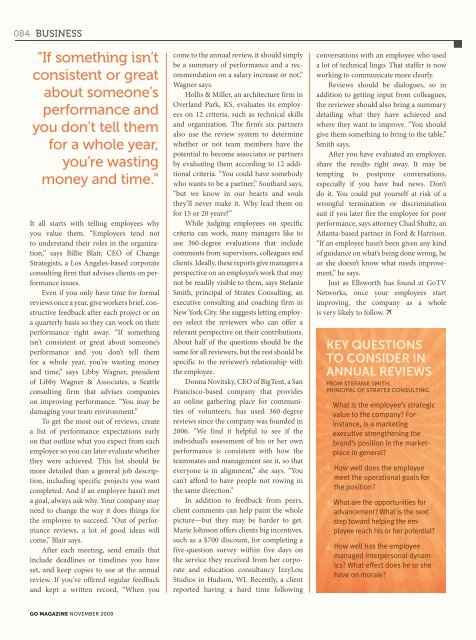Create successful ePaper yourself
Turn your PDF publications into a flip-book with our unique Google optimized e-Paper software.
084 BUSINESS<br />
“If something isn’t<br />
consistent or great<br />
about someone’s<br />
performance and<br />
you don’t tell them<br />
for a whole year,<br />
you’re wasting<br />
money and time.”<br />
It all starts with telling employees why<br />
you value them. “Employees tend not<br />
to understand their roles in the organization,”<br />
says Billie Blair, CEO of Change<br />
Strategists, a Los Angeles-based corporate<br />
consulting firm that advises clients on performance<br />
issues.<br />
Even if you only have time for formal<br />
reviews once a year, give workers brief, constructive<br />
feedback after each project or on<br />
a quarterly basis so they can work on their<br />
performance right away. “If something<br />
isn’t consistent or great about someone’s<br />
performance and you don’t tell them<br />
for a whole year, you’re wasting money<br />
and time,” says Libby Wagner, president<br />
of Libby Wagner & Associates, a Seattle<br />
consulting firm that advises companies<br />
on improving performance. “You may be<br />
damaging your team environment.”<br />
To get the most out of reviews, create<br />
a list of performance expectations early<br />
on that outline what you expect from each<br />
employee so you can later evaluate whether<br />
they were achieved. This list should be<br />
more detailed than a general job description,<br />
including specific projects you want<br />
completed. And if an employee hasn’t met<br />
a goal, always ask why. Your company may<br />
need to change the way it does things for<br />
the employee to succeed. “Out of performance<br />
reviews, a lot of good ideas will<br />
come,” Blair says.<br />
After each meeting, send emails that<br />
include deadlines or timelines you have<br />
set, and keep copies to use at the annual<br />
review. If you’ve offered regular feedback<br />
and kept a written record, “When you<br />
GO MAGAZINE NOVEMBER <strong>2009</strong><br />
come to the annual review, it should simply<br />
be a summary of performance and a recommendation<br />
on a salary increase or not,”<br />
Wagner says.<br />
Hollis & Miller, an architecture firm in<br />
Overland Park, KS, evaluates its employees<br />
on 12 criteria, such as technical skills<br />
and organization. The firm’s six partners<br />
also use the review system to determine<br />
whether or not team members have the<br />
potential to become associates or partners<br />
by evaluating them according to 12 additional<br />
criteria. “You could have somebody<br />
who wants to be a partner,” Southard says,<br />
“but we know in our hearts and souls<br />
they’ll never make it. Why lead them on<br />
for 15 or 20 years?”<br />
While judging employees on specific<br />
criteria can work, many managers like to<br />
use 360-degree evaluations that include<br />
comments from supervisors, colleagues and<br />
clients. Ideally, these reports give managers a<br />
perspective on an employee’s work that may<br />
not be readily visible to them, says Stefanie<br />
Smith, principal of Stratex Consulting, an<br />
executive consulting and coaching firm in<br />
New York City. She suggests letting employees<br />
select the reviewers who can offer a<br />
relevant perspective on their contributions.<br />
About half of the questions should be the<br />
same for all reviewers, but the rest should be<br />
specific to the reviewer’s relationship with<br />
the employee.<br />
Donna Novitsky, CEO of BigTent, a San<br />
Francisco-based company that provides<br />
an online gathering place for communities<br />
of volunteers, has used 360-degree<br />
reviews since the company was founded in<br />
2006. “We find it helpful to see if the<br />
individual’s assessment of his or her own<br />
performance is consistent with how the<br />
teammates and management see it, so that<br />
everyone is in alignment,” she says. “You<br />
can’t afford to have people not rowing in<br />
the same direction.”<br />
In addition to feedback from peers,<br />
client comments can help paint the whole<br />
picture—but they may be harder to get.<br />
Marie Johnson offers clients big incentives,<br />
such as a $700 discount, for completing a<br />
five-question survey within five days on<br />
the service they received from her corporate<br />
and education consultancy IzzyLou<br />
Studios in Hudson, WI. Recently, a client<br />
reported having a hard time following<br />
conversations with an employee who used<br />
a lot of technical lingo. That staffer is now<br />
working to communicate more clearly.<br />
Reviews should be dialogues, so in<br />
addition to getting input from colleagues,<br />
the reviewee should also bring a summary<br />
detailing what they have achieved and<br />
where they want to improve. “You should<br />
give them something to bring to the table,”<br />
Smith says.<br />
After you have evaluated an employee,<br />
share the results right away. It may be<br />
tempting to postpone conversations,<br />
especially if you have bad news. Don’t<br />
do it. You could put yourself at risk of a<br />
wrongful termination or discrimination<br />
suit if you later fire the employee for poor<br />
performance, says attorney Chad Shultz, an<br />
Atlanta-based partner in Ford & Harrison.<br />
“If an employee hasn’t been given any kind<br />
of guidance on what’s being done wrong, he<br />
or she doesn’t know what needs improvement,”<br />
he says.<br />
Just as Ellsworth has found at GoTV<br />
Networks, once your employees start<br />
improving, the company as a whole<br />
is very likely to follow.<br />
KEY QUESTIONS<br />
TO CONSIDER IN<br />
ANNUAL REVIEWS<br />
FROM STEFANIE SMITH,<br />
PRINCIPAL OF STRATEX CONSULTING<br />
1. What is the employee’s strategic<br />
value to the company? For<br />
instance, is a marketing<br />
executive strengthening the<br />
brand’s position in the marketplace<br />
in general?<br />
2. How well does the employee<br />
meet the operational goals for<br />
the position?<br />
3. What are the opportunities for<br />
advancement? What is the next<br />
step toward helping the employee<br />
reach his or her potential?<br />
4. How well has the employee<br />
managed interpersonal dynamics?<br />
What effect does he or she<br />
have on morale?
















